Effect of Ferrite Core Modification on Electromagnetic Force Considering Spatial Harmonics in an Induction Cooktop
Abstract
:1. Introduction
2. Electromagnetic Output Analysis Based on Ferrite Core
2.1. Operating Principle of the Induction Cooktop
2.2. Output Analysis of the Base Model Using FEM
2.3. Ferrite Shape Modification Models
- Figure 5a: This part shows the large ferrite. The height is higher at the outer part, shortening the air gap and resulting in a higher distribution of magnetic flux density.
- Figure 5b: This part shows the small ferrite. The ferrite diminishes toward the outer region, leading to a lower magnetic flux density.
- Figure 5c: This part shows the magnetic flux density in the air gap where there is no ferrite. It is evident that even without the ferrite, magnetic flux density is generated near the center of the cookware.
- Model #1: Based on Figure 5a, since the outer part of the large ferrite is closer to the air gap, increasing the magnetic flux density, the outer part of the small ferrite was modified to match the large ferrite’s shape, thereby shortening the air gap.
- Model #2 and Model #3: Circular ferrites were added to the inner part of the base model’s ferrite to shorten the air gap, with heights of 5 mm and 7 mm, respectively.
- Model #4 and Model #5: These models combine Model #1 with Model #2 and Model #3, respectively, to observe the interaction between these shapes.
- Model #6 and Model #7: These models isolate the effect of the inner ferrite by removing the outer end of the large ferrite from Models #2 and #3, respectively.
2.4. Output Analysis of Ferrite Shape Modification Models Using FEM
- Model #1: This model modifies the outer shape of the small ferrite to match the outer shape of the large ferrite. The ohmic loss density distribution for Model #1 is shown in Figure 7a. The calculated output, obtained by integrating the volume of the ohmic loss density, is 1733.7 W, representing a 5.8% increase compared to the base model. Comparing this with the base model’s ohmic loss density distribution in Figure 4b, the loss area has significantly expanded towards the outer region, indicating an increase in output. Thus, altering the outer shape of the small ferrite to match that of the large ferrite enhances the output.
- Model #2 and Model #3: These models add circular ferrites to the inner part of the base model’s ferrite to shorten the air gap. The ohmic loss density distributions are shown in Figure 7b,c, respectively. The calculated outputs are 1776.7 W for Model #2 and 1833.4 W for Model #3. Model #3, with a shorter air gap, shows a significant increase in output. This is because the addition of the inner ferrite increases the area of the ohmic loss density distribution towards the center of the cookware. Therefore, adding inner ferrites not only results in higher output but also generates more uniform heat compared to the base model.
- Model #4 and Model #5: These models combine the modifications of Model #1 with those of Models #2 and #3. The outputs, influenced by the newly applied ferrite shapes, increase significantly compared to the previous models. Figure 7d,e show the ohmic loss density distributions for Models #4 and #5, respectively. When the small ferrite is applied, the loss area expands towards the outer part of the cookware. With the addition of the inner circular ferrite, the loss area also increases towards the center. The calculated outputs are 1868.6 W for Model #4 and 1923.6 W for Model #5, showing that the output increase from Model #1 is added to the outputs of Models #2 and #3.
- Model #6 and Model #7: These models add circular ferrites and remove the outer end of the large ferrite. The ohmic loss density distributions are shown in Figure 7f,g, respectively. The calculated outputs are 1630 W for Model #6 and 1686.0 W for Model #7, showing a slight decrease compared to the base model. The distribution of ohmic loss density indicates a concentration towards the center of the cookware, resulting in a slight reduction in the loss area and, consequently, the output.
3. Spatial Harmonic Analysis of Forces in the Air Gap
3.1. Forces in the Air Gap of an Induction Cooktop
3.2. Noise and Current Measurement of the Base Model
3.3. Spatial Harmonic Analysis Using Air Gap Flux Density
- Force calculation using Equation (3):Calculate the force generated in the air gap based on the magnetic flux density distribution. This calculation considers the contribution of the electromagnetic fields and the interactions between the coil and the cookware.
- FFT over time:Perform an FFT on the calculated force over time to identify the dominant frequency components. Given the operational and switching frequency characteristics of the cooktop, we focus on the 2nd harmonic of the 60 Hz component, which is 120 Hz.
- FFT over space:Conduct an FFT over the spatial distribution of the force. This spatial FFT helps identify the harmonic components introduced by the ferrite shapes. We specifically look for the 0th and 8th spatial harmonic components, as these are prominent in the ferrite shape analysis.
- Analysis of direction components:Analyze the FFT components in the direction (radial direction in the cylindrical coordinate system). By examining these components, we can determine the impact of different ferrite shapes on the overall force distribution and, consequently, on the generated noise.
- Magnitude comparison:Compare the magnitudes of the harmonic components to evaluate the effectiveness of different ferrite configurations. This comparison helps identify which configurations minimize undesirable harmonic components and reduce noise.
3.4. Harmonic Analysis of Spatial Components by Ferrite Shape
- Reducing the inner air gap length increases the ϕ = 0 component significantly.
- Modifying the outer ferrite shape changes the spatial harmonic pattern, shifting from = 8 to = 16 components.
- The = 0 component dominates the 120 Hz spatial harmonics, influencing the noise characteristics of the induction cooktop.
4. Experiments
4.1. Selection of Experimental Models
4.2. Noise Experiments
4.3. Current Measurement
- Base Model: 16.74 A (as shown in Figure 13)
- Model #8: 16.64 A
- Model #9: 16.16 A
4.4. Summary
5. Conclusions
- Reducing the outer air gap length decreases the = 0 harmonic component, while reducing the inner air gap length significantly increases the = 0 component.
- Models with reduced inner air gaps demonstrated notable performance increases, evidenced by higher power output and lower current requirements.
- Modifications to the inner air gap had a more substantial impact on the central z-direction force component ( = 0), contributing to increased performance and higher noise levels.
- Two experimental models were selected based on simulation results: Model #8 (reduced outer air gap) and Model #9 (reduced inner air gap).
- Noise measurements revealed that Model #8 reduced 120 Hz harmonic noise components compared to the base model, while Model #9 exhibited increased noise levels due to higher excitation forces.
- Current measurements confirmed that Model #9 achieved improved efficiency, with RMS current reduced to 94.54% of the base model, indicating significant performance gains from inner air gap reduction.
- A critical trade-off was observed between performance and noise levels. Inner air gap reduction (Model #9) led to higher efficiency and power output but also increased noise levels due to enhanced harmonic forces.
- Conversely, outer air gap reduction (Model #8) provided a balanced improvement in noise reduction without drastically compromising performance.
Author Contributions
Funding
Data Availability Statement
Conflicts of Interest
References
- Lucia, O.; Acero, J.; Carretero, C.; Burdio, J.M. Induction heating appliances: Toward more flexible cooking surfaces. IEEE Ind. Electron. Mag. 2013, 7, 35–47. [Google Scholar] [CrossRef]
- Peters, P.H. A portable cool-surface induction cooking appliance. IEEE Trans. Ind. Appl. 1974, 6, 814–822. [Google Scholar] [CrossRef]
- Tanaka, T. A new induction cooking range for heating any kind of metal vessels. IEEE Trans. Consum. Electron. 1989, 35, 635–641. [Google Scholar] [CrossRef]
- Dowell, P.L. Effects of eddy currents in transformer windings. In Proceedings of the Institution of Electrical Engineers; IET Digital Library: London, UK, 1966; pp. 1387–1394. [Google Scholar]
- Acero, J.; Burdio, J.M.; Barragan, L.A.; Navarro, D.; Alonso, R.; Ramon, J.; Monterde, F.; Hernandez, P.; Llorente, S.; Garde, I. Domestic induction appliances. IEEE Ind. Appl. Mag. 2010, 16, 39–47. [Google Scholar] [CrossRef]
- Lucia, O.; Maussion, P.; Dede, E.J.; Burdio, J.M. Induction heating technology and its applications: Past developments, current technology, and future challenges. IEEE Trans. Ind. Electron. 2013, 61, 2509–2520. [Google Scholar] [CrossRef]
- Acero, J.; Navarro, D.; Barragan, L.A.; Garde, I.; Artigas, J.I.; Burdio, J.M. FPGA-based power measuring for induction heating appliances using sigma–delta A/D conversion. IEEE Trans. Ind. Electron. 2007, 54, 1843–1852. [Google Scholar] [CrossRef]
- Forest, F.; Faucher, S.; Gaspard, J.-Y.; Montloup, D.; Huselstein, J.-J.; Joubert, C. Frequency-synchronized resonant converters for the supply of multiwinding coils in induction cooking appliances. IEEE Trans. Ind. Electron. 2007, 54, 441–452. [Google Scholar] [CrossRef]
- Lasobras, J.; Alonso, R.; Carretero, C.; Carretero, E.; Imaz, E. Infrared sensor-based temperature control for domestic induction cooktops. Sensors 2014, 14, 5278–5295. [Google Scholar] [CrossRef]
- Jimenez, O.; Lucia, O.; Urriza, I.; Barragan, L.A.; Navarro, D.; Dinavahi, V. Implementation of an FPGA-based online hardware-in-the-loop emulator using high-level synthesis tools for resonant power converters applied to induction heating appliances. IEEE Trans. Ind. Electron. 2014, 62, 2206–2214. [Google Scholar] [CrossRef]
- Sarnago, H.; Burdio, J.M.; Lucia, O. High-performance and cost-effective ZCS matrix resonant inverter for total active surface induction heating appliances. IEEE Trans. Power Electron. 2018, 34, 117–125. [Google Scholar] [CrossRef]
- Sarnago, H.; Guillen, P.; Burdio, J.M.; Lucia, O. Multiple-output ZVS resonant inverter architecture for flexible induction heating appliances. IEEE Access 2019, 7, 157046–157056. [Google Scholar] [CrossRef]
- Sarnago, H.; Lucia, O.; Burdio, J.M. FPGA-Based resonant load identification technique for flexible induction heating appliances. IEEE Trans. Ind. Electron. 2018, 65, 9421–9428. [Google Scholar] [CrossRef]
- Singh, S.K.; Agarwal, A.; Kanumuri, T.; Roy, M. Modelling and Controlling of Induction Heating Unit for Induction Cooking Application. J. Phys. Conf. Ser. 2020, 1478, 012010. [Google Scholar] [CrossRef]
- Huang, M.-S.; Liao, C.-C.; Li, Z.-F.; Shih, Z.-R.; Hsueh, H.-W. Quantitative design and implementation of an induction cooker for a copper pan. IEEE Access 2020, 9, 5105–5118. [Google Scholar] [CrossRef]
- Villa, J.; Dominguez, A.; Barragan, L.A.; Artigas, J.I.; Espanol, J.; Navarro, D. Conductance control for electromagnetic-compatible induction heating appliances. IEEE Trans. Power Electron. 2021, 37, 2909–2920. [Google Scholar] [CrossRef]
- Acero, J.; Hernandez, P.; Burdio, J.; Alonso, R.; Barragdan, L. Simple resistance calculation in litz-wire planar windings for induction cooking appliances. IEEE Trans. Magn. 2005, 41, 1280–1288. [Google Scholar] [CrossRef]
- Koller, L.; Novák, B. Improving the energy efficiency of induction cooking. Electr. Eng. 2009, 91, 153–160. [Google Scholar] [CrossRef]
- Serrano, J.; Acero, J.; Alonso, R.; Carretero, C.; Lope, I.; Burdío, J.M. Design and implementation of a test-bench for efficiency measurement of domestic induction heating appliances. Energies 2016, 9, 636. [Google Scholar] [CrossRef]
- Acero, J.; Burdio, J.M.; Barragan, L.A.; Navarro, D.; Alonso, R.; Garcia, J.R.; Monterde, F.; Hernandez, P.; Garde, S.L.I. The domestic induction heating appliance: An overview of recent research. In Proceedings of the 2008 Twenty-Third Annual IEEE Applied Power Electronics Conference and Exposition, Austin, TX, USA, 24–28 February 2008; IEEE: Piscataway, NJ, USA, 2008; pp. 651–657. [Google Scholar]
- Carretero, C.; Lucia, O.; Acero, J.; Burdio, J.M. Computational modeling of two partly coupled coils supplied by a double half-bridge resonant inverter for induction heating appliances. IEEE Trans. Ind. Electron. 2012, 60, 3092–3105. [Google Scholar] [CrossRef]
- Humza, M.; Kim, B. Analysis and optimal design of induction heating cookers. J. Electr. Eng. Technol. 2016, 11, 1282–1288. [Google Scholar] [CrossRef]
- Plumed, E.; Lope, I.; Acero, J.; Burdio, J.M. Domestic induction heating system with standard primary inductor for reduced-size and high distance cookware. IEEE Trans. Ind. Appl. 2022, 58, 7562–7571. [Google Scholar] [CrossRef]
- Plumed, E.; Lope, I.; Acero, J. Modeling and design of cookware for induction heating technology with balanced electromagnetic and thermal characteristics. IEEE Access 2022, 10, 83793–83801. [Google Scholar] [CrossRef]
- Lucia, O.; Navarro, D.; Guillen, P.; Sarnago, H.; Lucia, S. Deep learning-based magnetic coupling detection for advanced induction heating appliances. IEEE Access 2019, 7, 181668–181677. [Google Scholar] [CrossRef]
- Villa, J.; Navarro, D.; Dominguez, A.; Artigas, J.I.; Barragan, L.A. vessel recognition in induction heating appliances—A deep-learning approach. IEEE Access 2021, 9, 16053–16061. [Google Scholar] [CrossRef]
- Hironobu, Y.; Natsumi, T. Acoustic Noise of IH Cooker Caused by the Power Supply Noise. J. Biomed. Syst. Emerg. Technol. S 2021, 1, 7. [Google Scholar]
- Villa, J.; Artigas, J.I.; Beltran, J.R.; Vicente, A.D.; Barragan, L.A. Analysis of acoustic noise spectrum of domestic induction heating systems controlled by phase-accumulator modulators. IEEE Trans. Ind. Electron. 2019, 66, 5929–5938. [Google Scholar] [CrossRef]
- Meng, L.C.; Cheng, K.W.E.; Chan, K.W. Heating performance improvement and field study of the induction cooker. In Proceedings of the 2009 3rd International Conference on Power Electronics Systems and Applications (PESA), Hong Kong, China, 20–22 May 2009; IEEE: Piscataway, NJ, USA, 2009; pp. 1–5. [Google Scholar]
- Hu, Q.; Chen, W.; Huang, T.; Chen, Q. The analysis of near-field magnetic leakage on the domestic induction cooker. In Proceedings of the 2014 International Power Electronics and Application Conference and Exposition, Shanghai, China, 5–8 November 2014; IEEE: Piscataway, NJ, USA, 2014; pp. 605–608. [Google Scholar]
- Barba, P.; Dughiero, F.; Forzan, M.; Sieni, E. Sensitivity-based optimal shape design of induction-heating devices. IET Sci. Meas. Technol. 2015, 9, 579–586. [Google Scholar] [CrossRef]
- Kim, D.-S.; So, J.-Y.; Kim, D.-K. Study on heating performance improvement of practical induction heating rice cooker with magnetic flux concentrator. IEEE Trans. Appl. Supercond. 2016, 26, 1–4. [Google Scholar] [CrossRef]
- Balabozov, I.; Brauer, H.; Yatchev, I. Modelling of magnetic concentrators in induction heating systems. In Proceedings of the 2017 15th International Conference on Electrical Machines, Drives and Power Systems (ELMA), Sofia, Bulgaria, 1–3 June 2017; IEEE: Piscataway, NJ, USA, 2017; pp. 453–456. [Google Scholar]
- Primiani, V.M.; Kovyryalov, S.; Cerri, G. Rigorous electromagnetic model of an induction cooking system. IET Sci. Meas. Technol. 2012, 6, 238–246. [Google Scholar] [CrossRef]
- Acero, J.; Lope, I.; Carretero, C.; Burdio, J.M. Analysis and modeling of the forces exerted on the cookware in induction heating applications. IEEE Access 2020, 8, 131178–131187. [Google Scholar] [CrossRef]
- Roberto, S.F.; Ala, G.; Favuzza, S.; Massaro, F.; Zizzo, G. Equivalent circuit modelling of ferrite inductors losses. In Proceedings of the 2018 IEEE 4th International Forum on Research and Technology for Society and Industry (RTSI), Palermo, Italy, 10–13 September 2018; IEEE: Piscataway, NJ, USA, 2018; pp. 1–4. [Google Scholar]
- Chen, H.-C.; Huang, K.-H. Finite element analysis of coupled electromagnetic and thermal fields within a practical induction heating cooker. Int. J. Appl. Electromagn. Mech. 2008, 28, 413–427. [Google Scholar] [CrossRef]
- Meessen, K.K.J.; Paulides, J.J.H.; Lomonova, E.A. Force calculations in 3-D cylindrical structures using Fourier analysis and the Maxwell stress tensor. IEEE Trans. Magn. 2012, 49, 536–545. [Google Scholar] [CrossRef]
- Wah, T. Vibration of circular plates. J. Acoust. Soc. Am. 1962, 34, 275–281. [Google Scholar] [CrossRef]
- Yun, G.; Lee, S.; Lukman, G.F.; Lee, C. Investigation of electromagnetic noise in an induction cooktop by examining circular membrane vibration modes in terms of their harmonics. AIP Adv. 2024, 14, 797. [Google Scholar] [CrossRef]
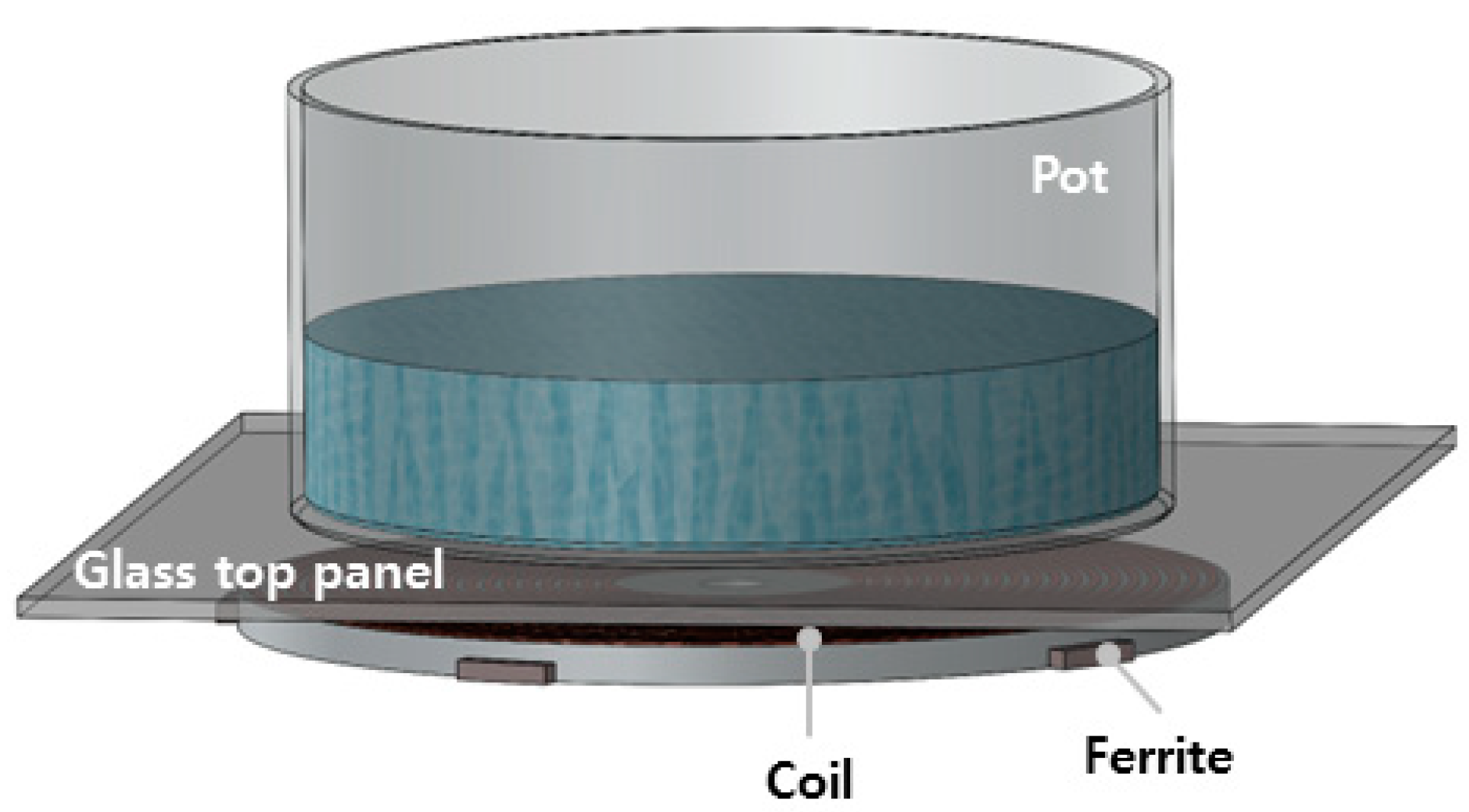
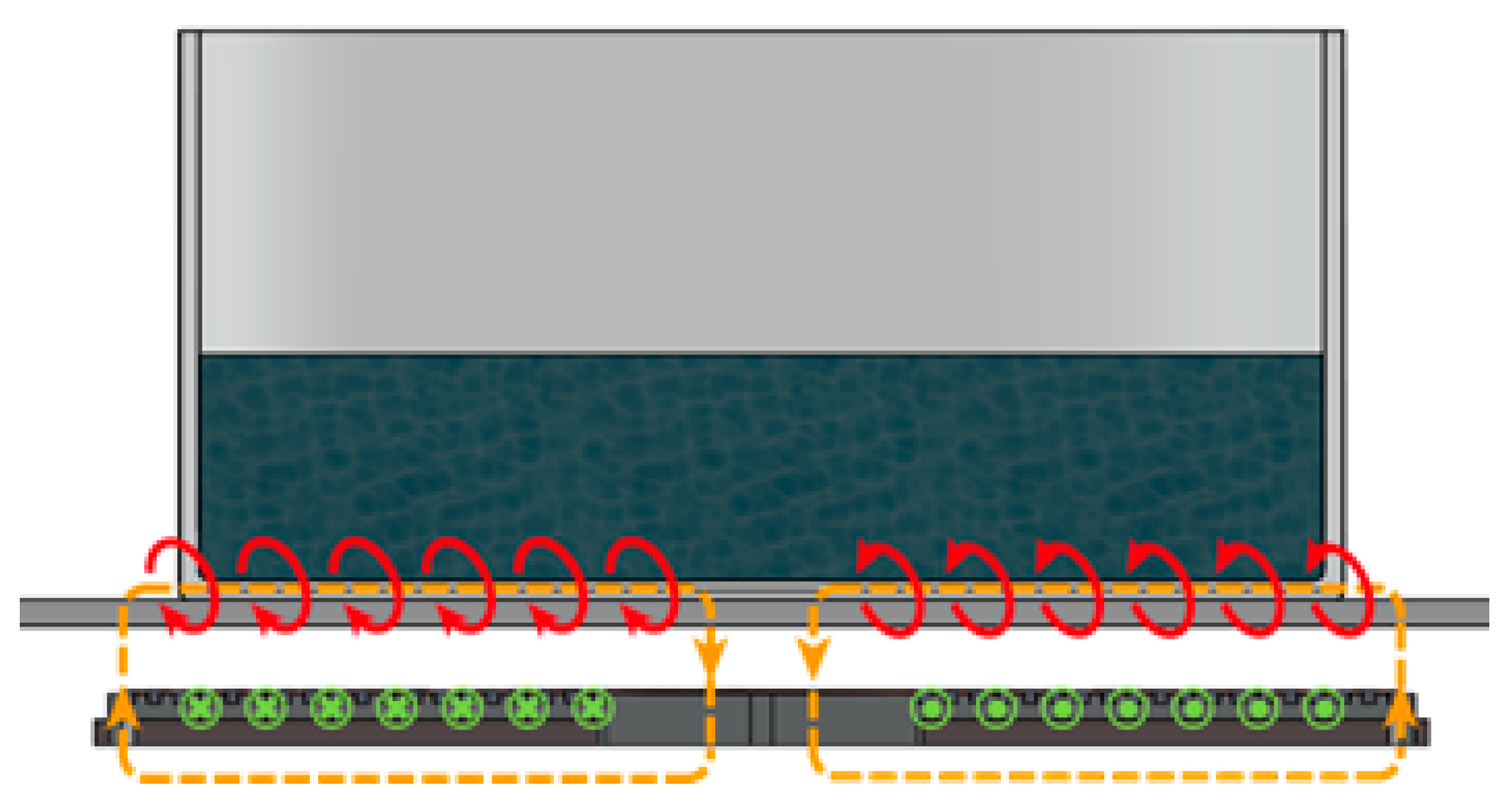

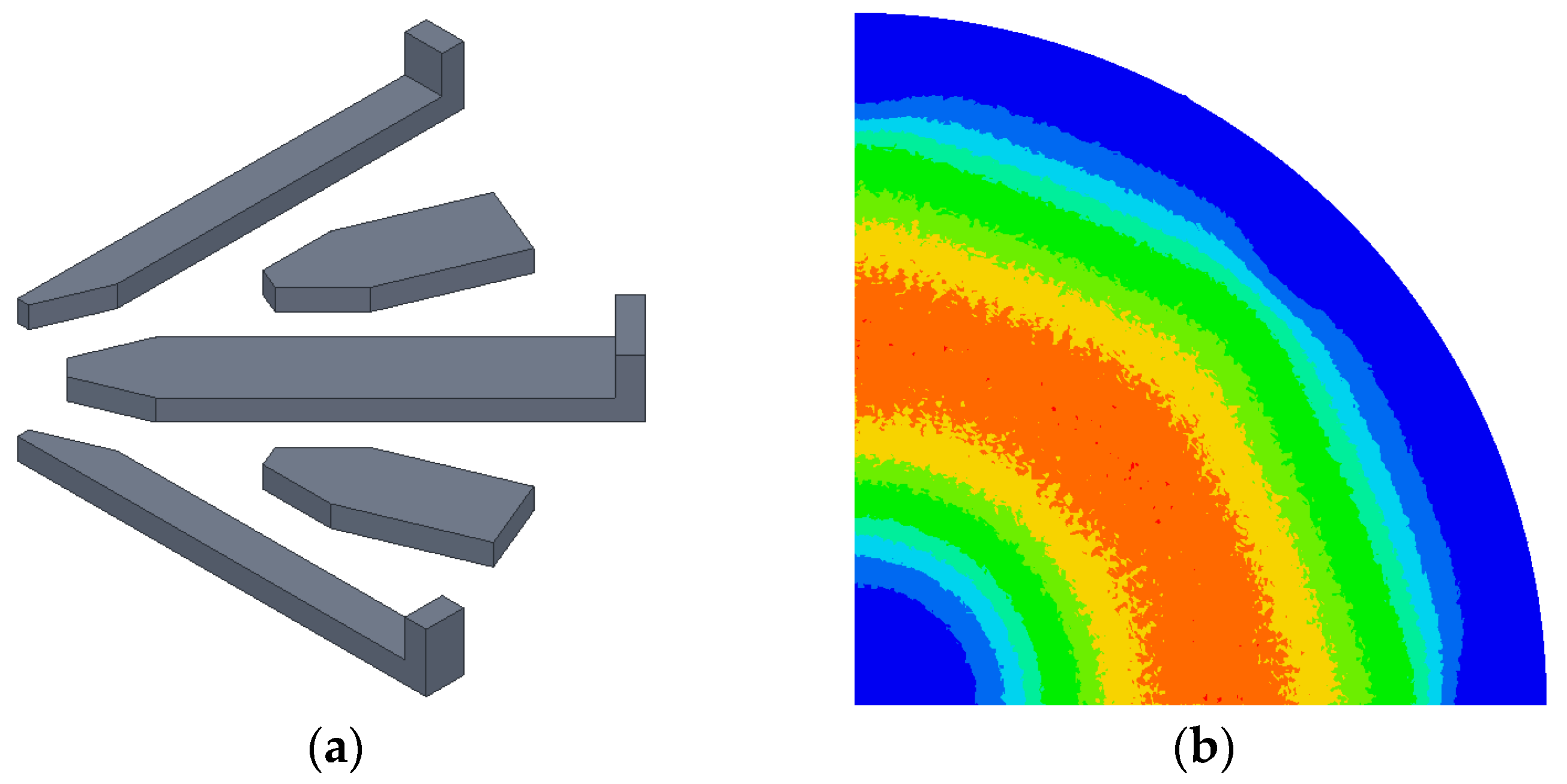



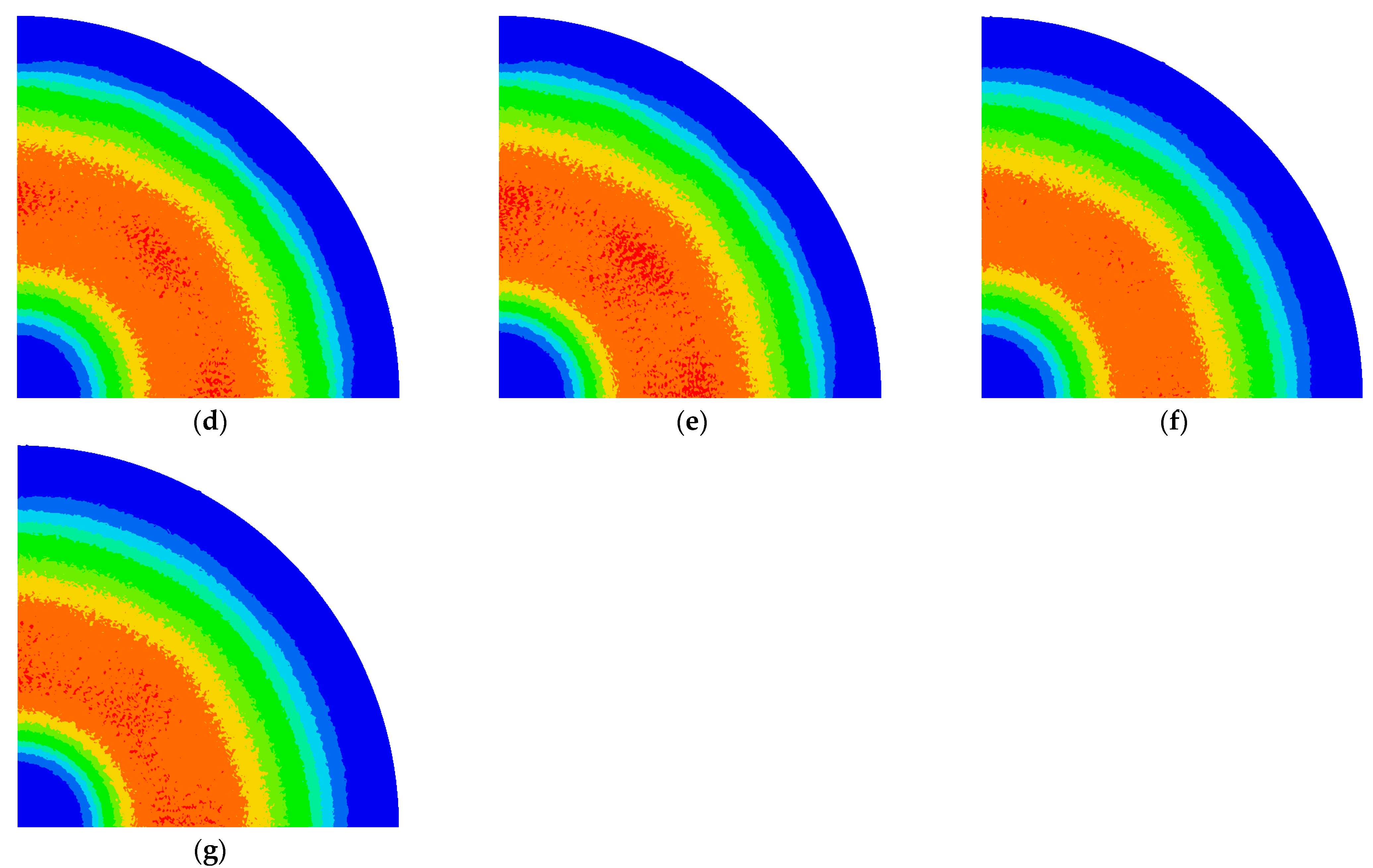
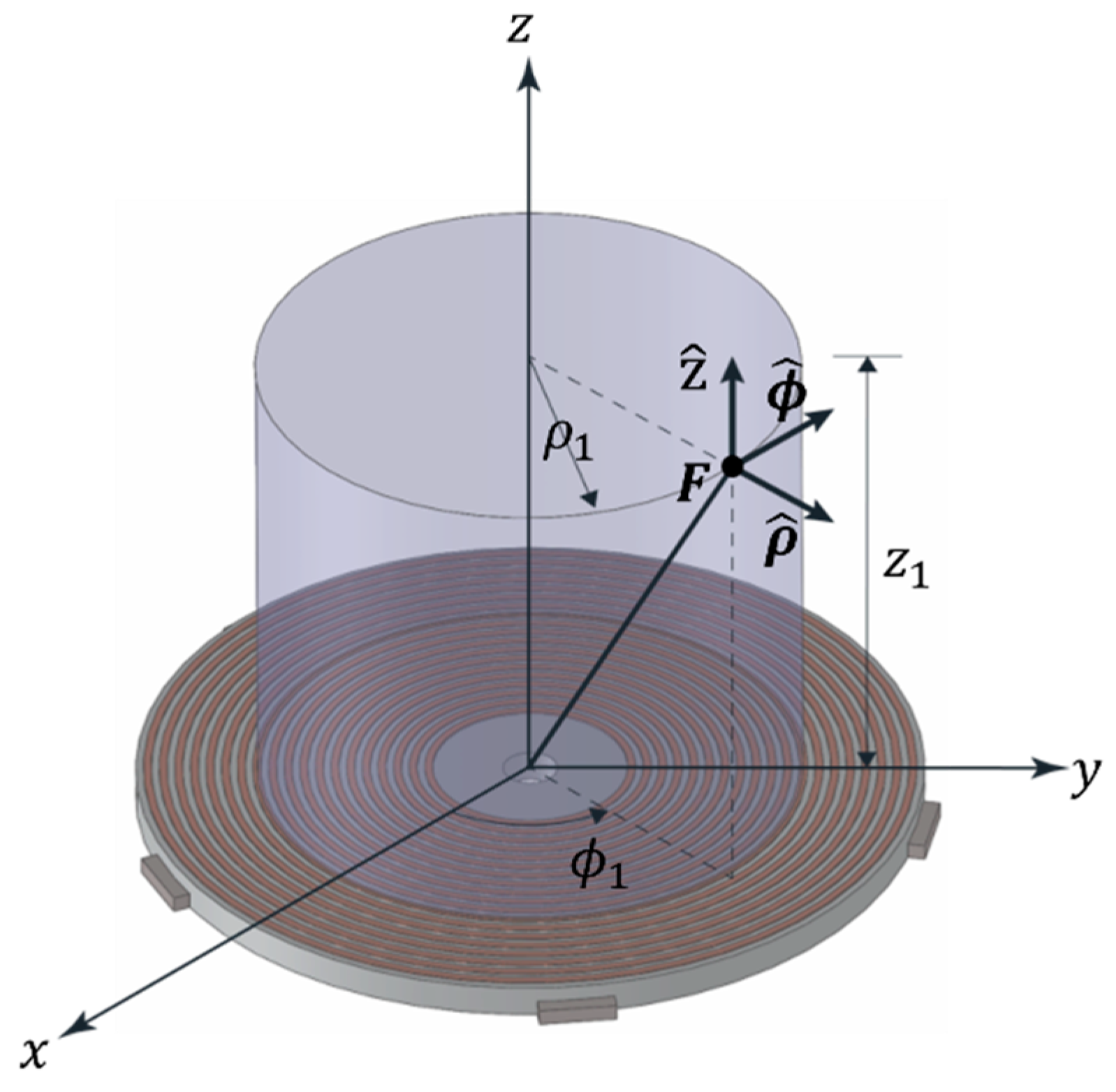

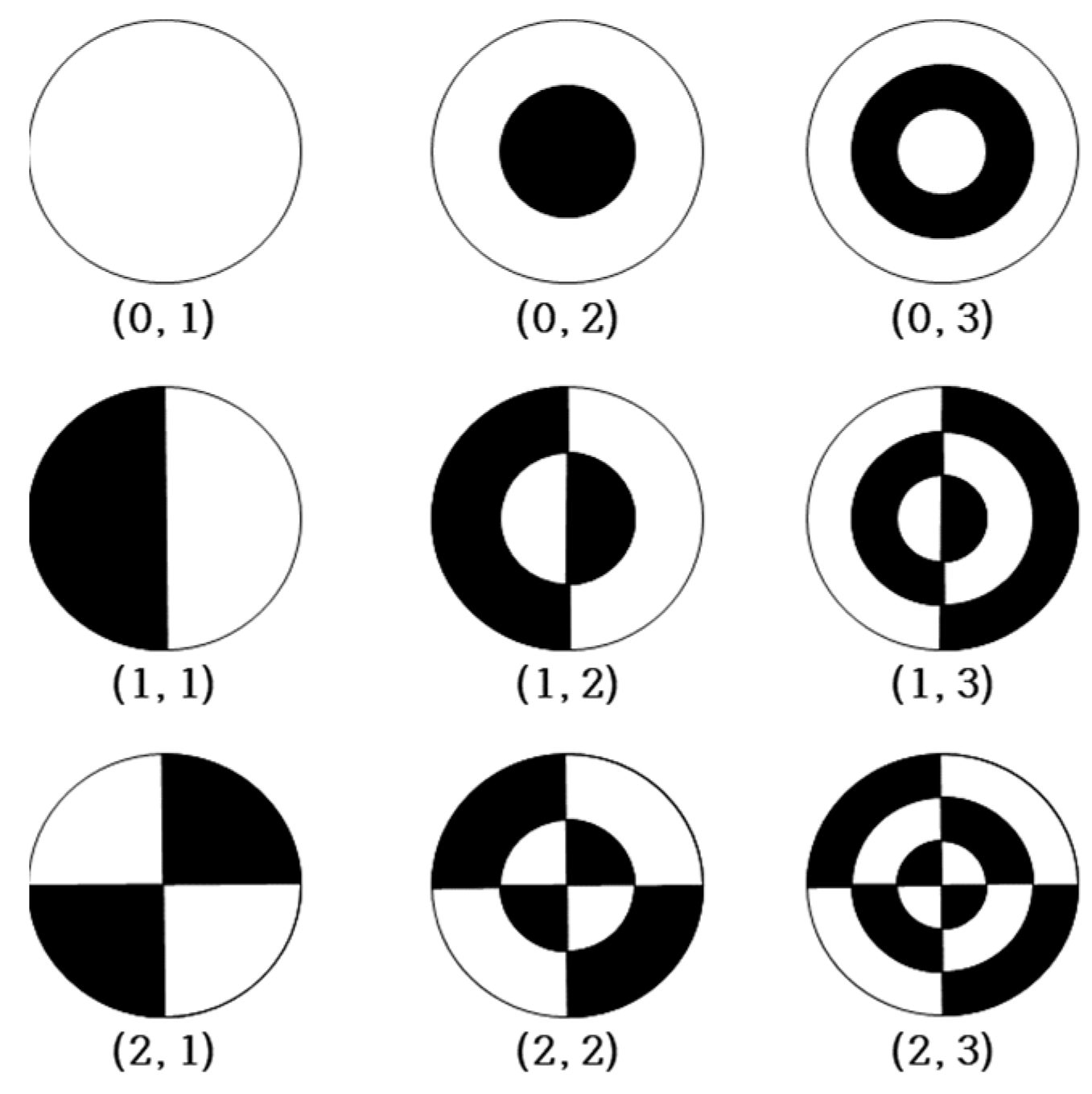
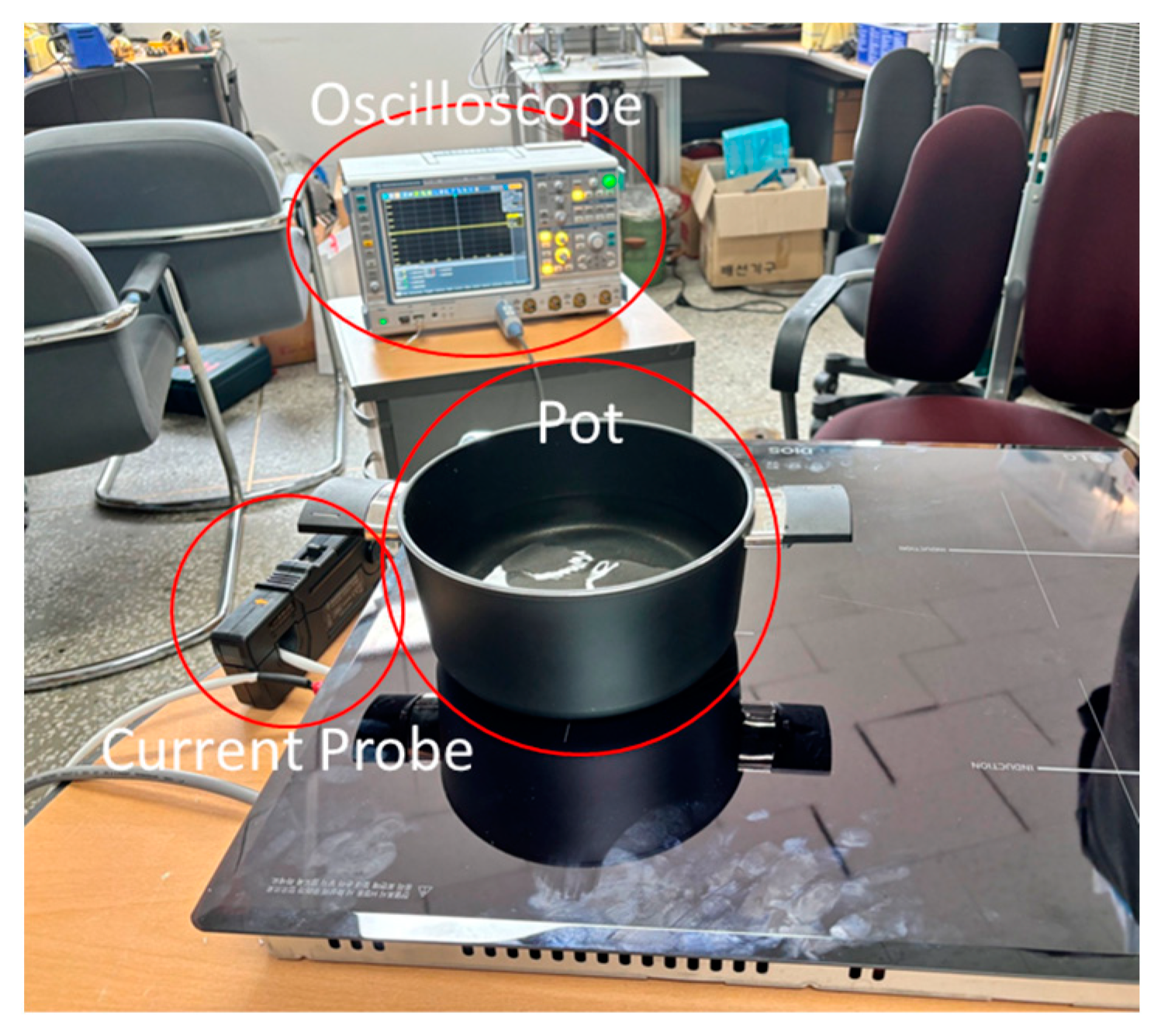
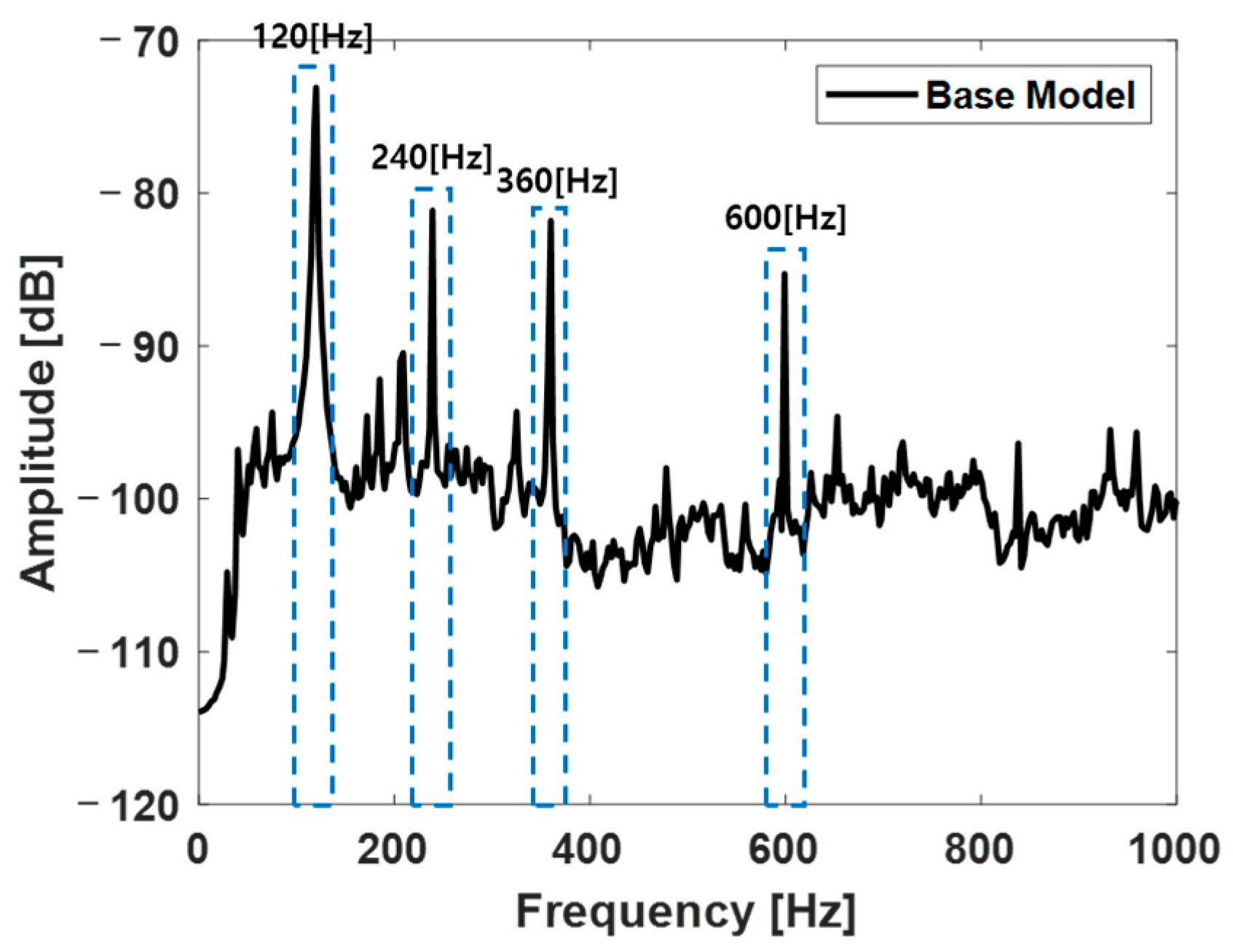
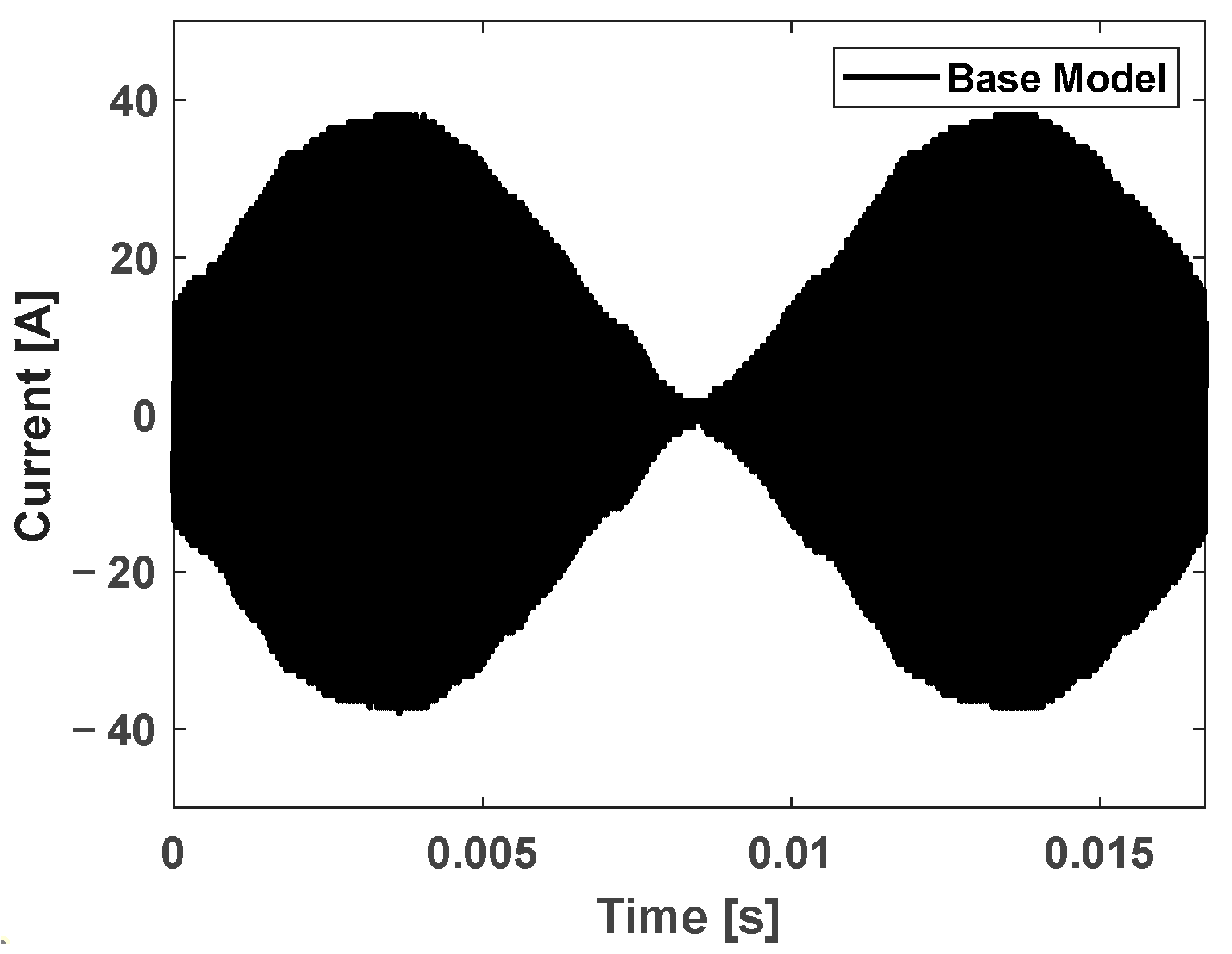
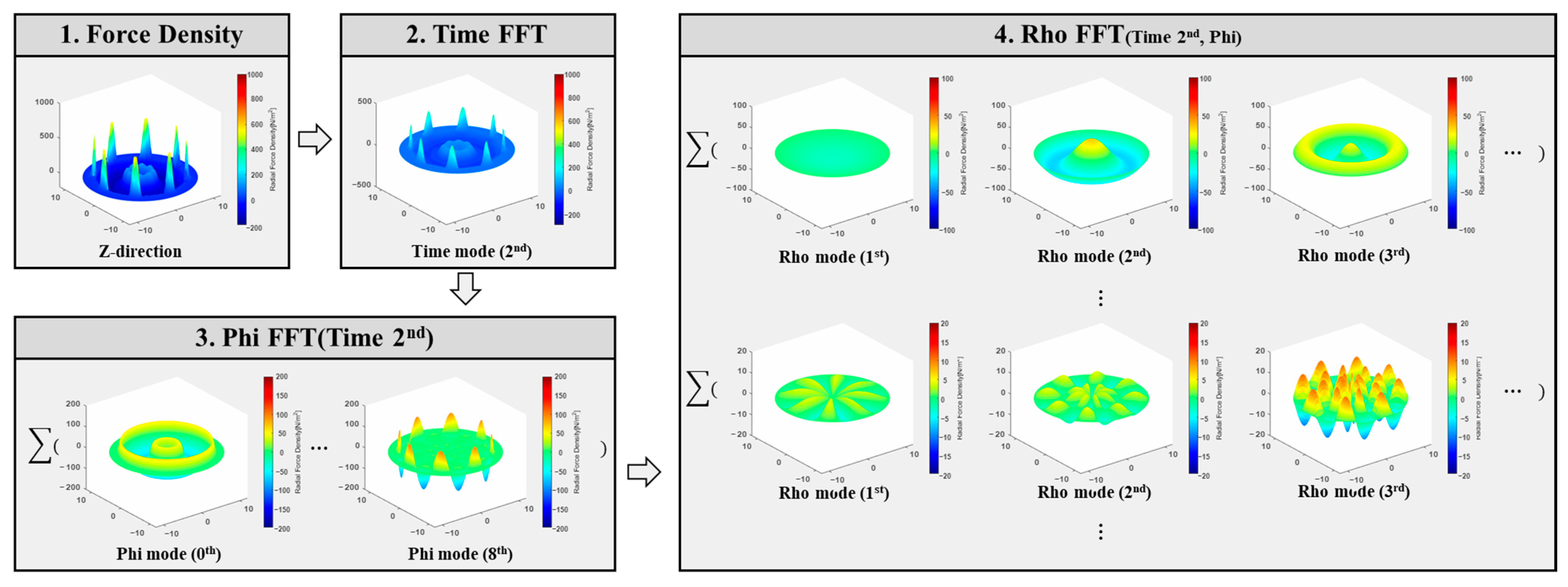


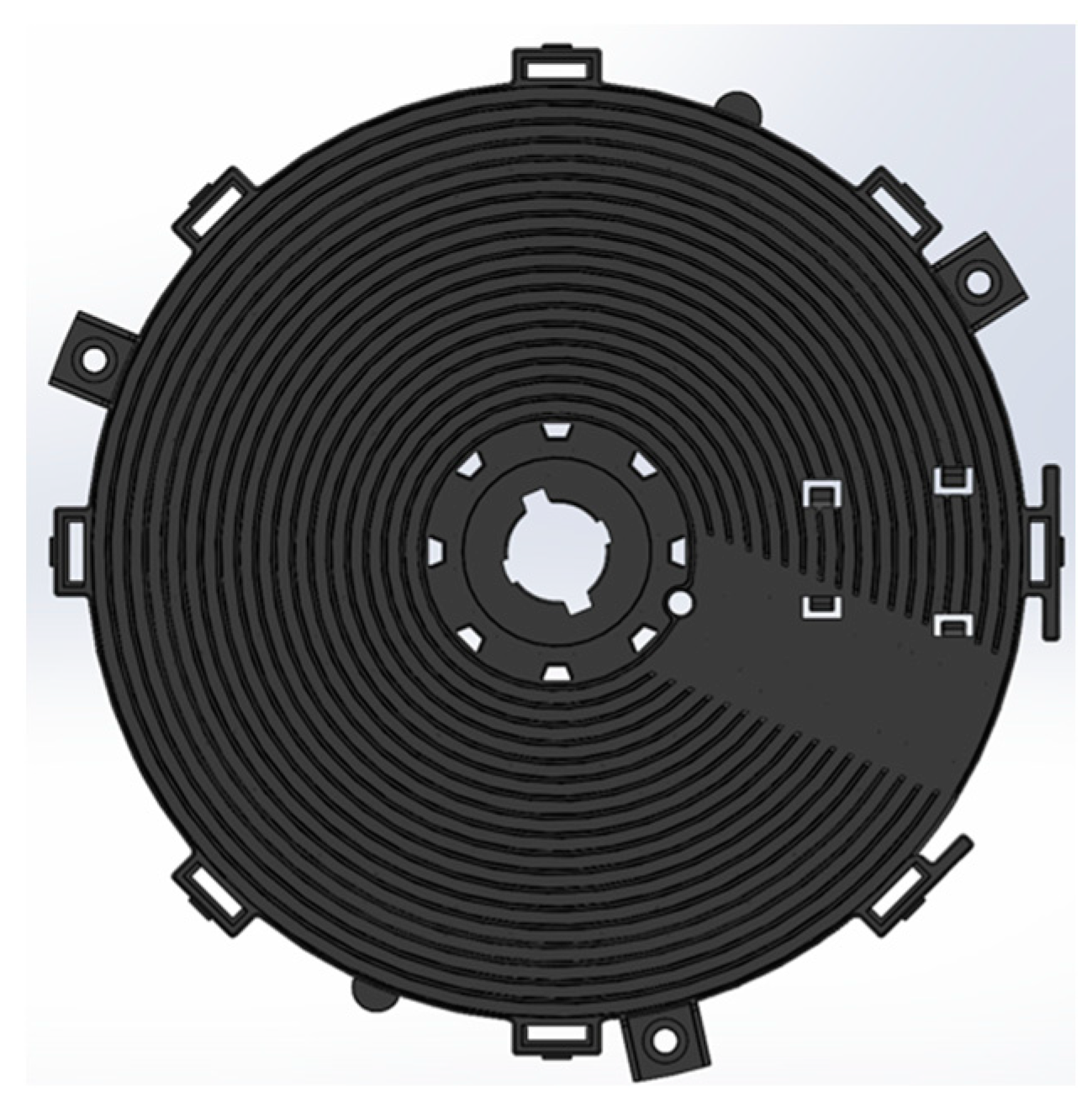
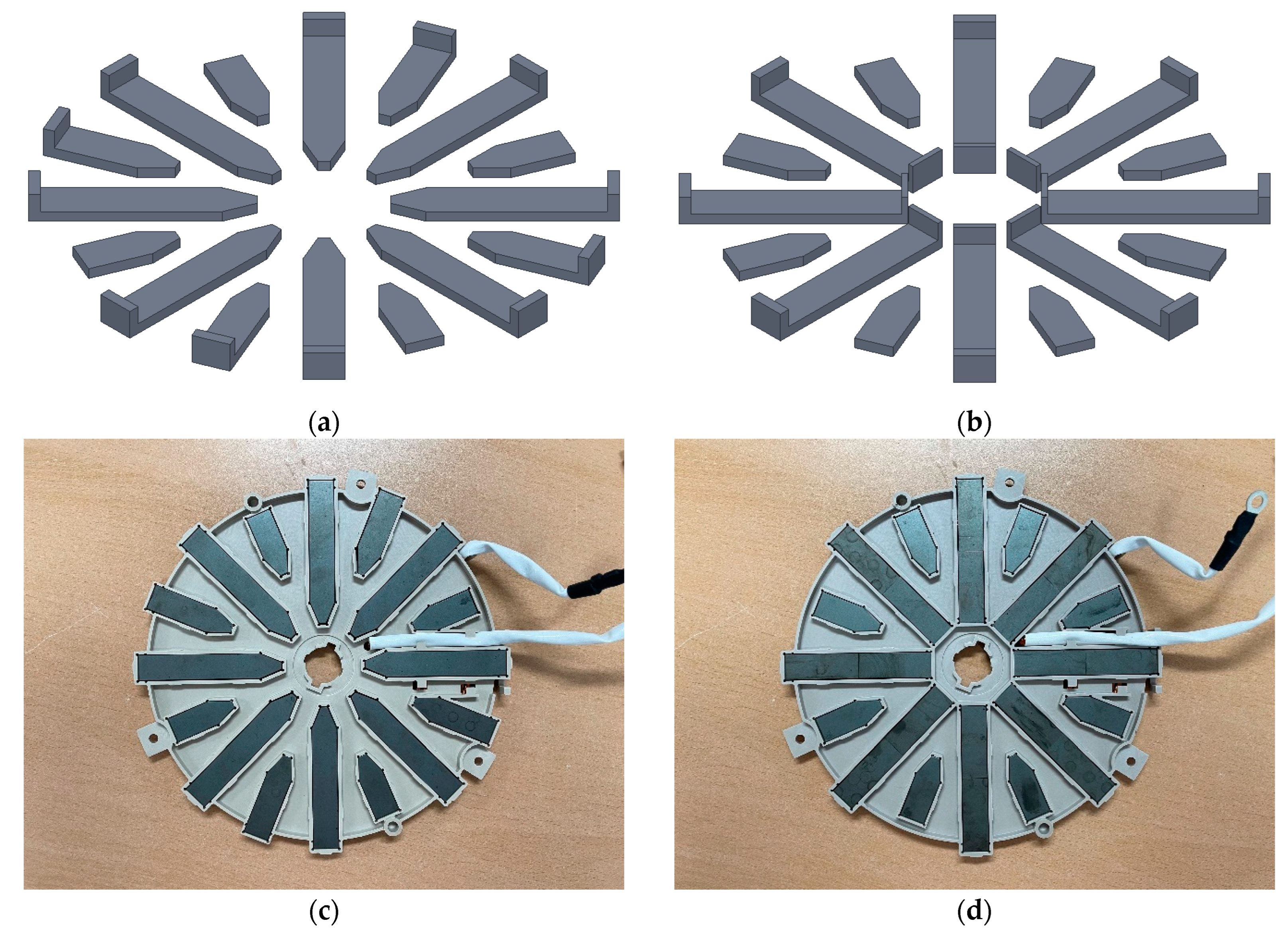
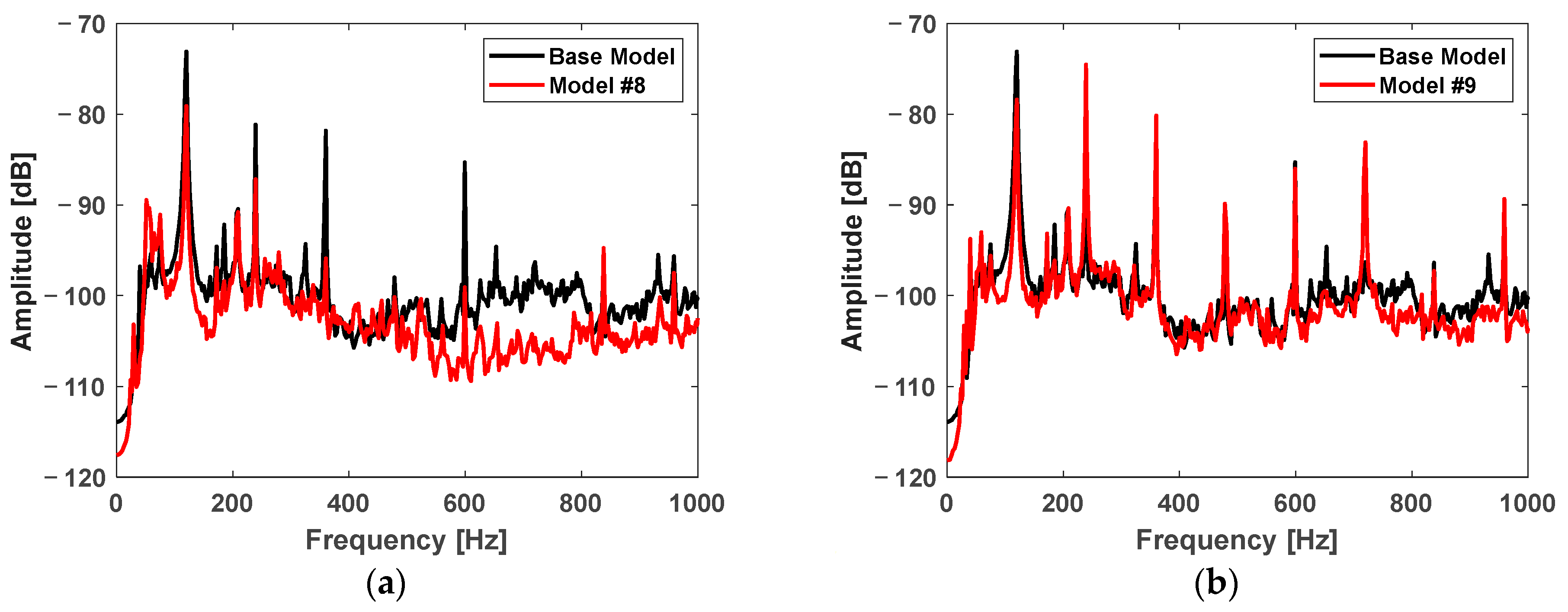
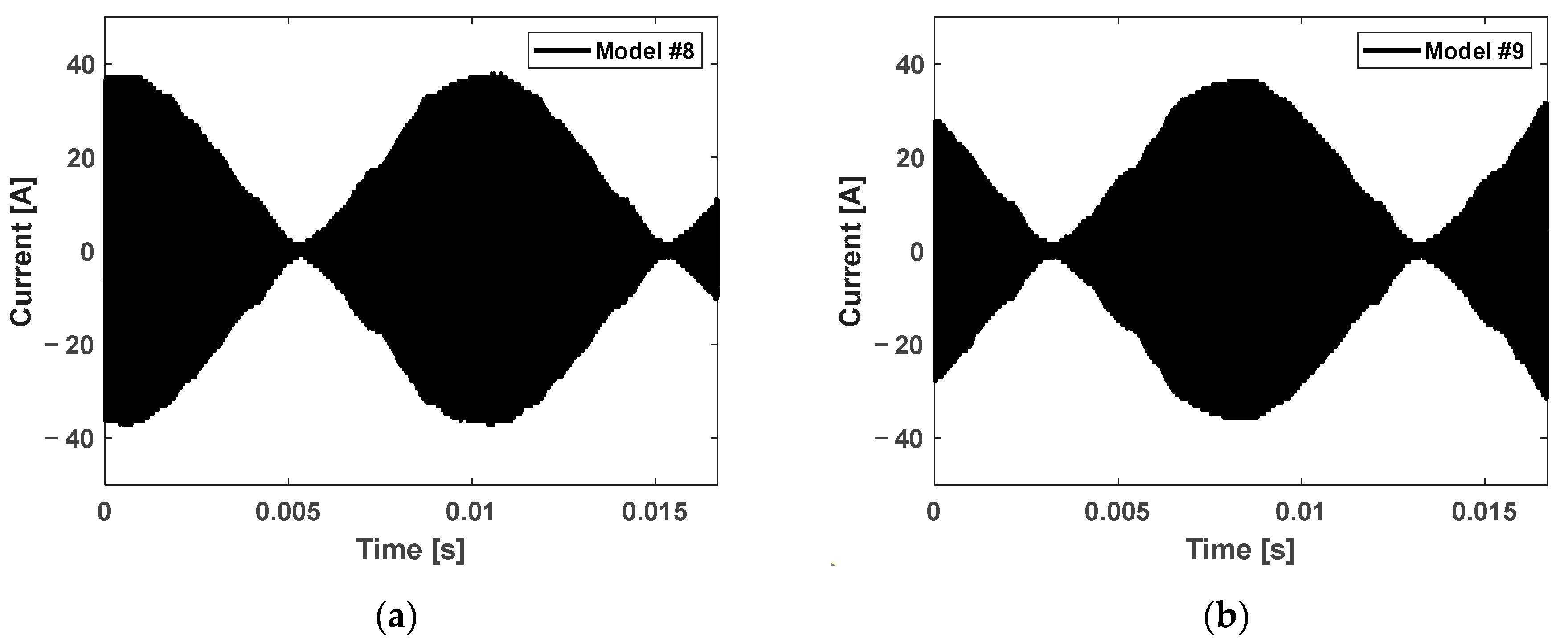
| Base Model | Model #1 | Model #2 | Model #3 | |
|---|---|---|---|---|
| Ferrite Volume [mm3] | 12,438 | 14,428 | 13,208 | 13,514 |
| 100.0% | 116.0% | 106.2% | 108.7% | |
| Output [W] | 1638.6 | 1733.7 | 1776.7 | 1833.4 |
| 100.0% | 105.8% | 108.4% | 111.9% | |
| Model #4 | Model #5 | Model #6 | Model #7 | |
| Ferrite Volume [mm3] | 15,198 | 15,506 | 12,424 | 12,732 |
| 122.2% | 124.7% | 99.9% | 102.4% | |
| Output [W] | 1868.6 | 1923.6 | 1630.0 | 1686.0 |
| 114.0% | 117.4% | 99.5% | 102.9% |
| Frequency [Hz] | Base Model | Model #8 | Model #9 |
|---|---|---|---|
| 120 | −73.09 | −79.09 | −78.38 |
| 240 | −81.13 | −87.16 | −74.51 |
| 360 | −81.81 | −95.88 | −80.14 |
| 480 | −97.98 | −100.17 | −89.87 |
| 600 | −85.28 | −99.05 | −86.01 |
| 720 | −96.29 | −104.65 | −83.09 |
| 840 | −104.50 | −104.03 | −102.94 |
| 960 | −95.65 | −97.50 | −89.35 |
Disclaimer/Publisher’s Note: The statements, opinions and data contained in all publications are solely those of the individual author(s) and contributor(s) and not of MDPI and/or the editor(s). MDPI and/or the editor(s) disclaim responsibility for any injury to people or property resulting from any ideas, methods, instructions or products referred to in the content. |
© 2024 by the authors. Licensee MDPI, Basel, Switzerland. This article is an open access article distributed under the terms and conditions of the Creative Commons Attribution (CC BY) license (https://creativecommons.org/licenses/by/4.0/).
Share and Cite
Lee, S.; Yun, G.; Lukman, G.F.; Kim, J.-M.; Kim, T.-H.; Lee, C. Effect of Ferrite Core Modification on Electromagnetic Force Considering Spatial Harmonics in an Induction Cooktop. Energies 2024, 17, 4744. https://doi.org/10.3390/en17184744
Lee S, Yun G, Lukman GF, Kim J-M, Kim T-H, Lee C. Effect of Ferrite Core Modification on Electromagnetic Force Considering Spatial Harmonics in an Induction Cooktop. Energies. 2024; 17(18):4744. https://doi.org/10.3390/en17184744
Chicago/Turabian StyleLee, Sangjin, Gyeonghwan Yun, Grace Firsta Lukman, Jang-Mok Kim, Tae-Hoon Kim, and Cheewoo Lee. 2024. "Effect of Ferrite Core Modification on Electromagnetic Force Considering Spatial Harmonics in an Induction Cooktop" Energies 17, no. 18: 4744. https://doi.org/10.3390/en17184744







